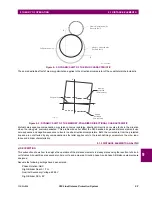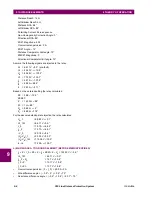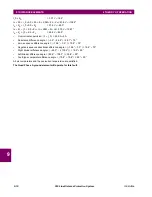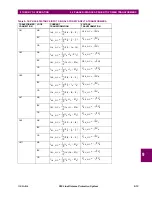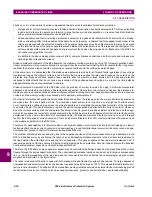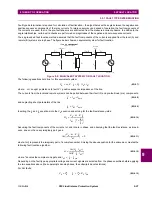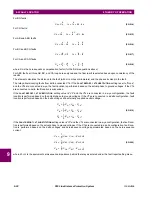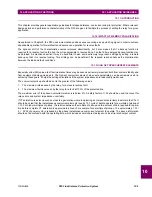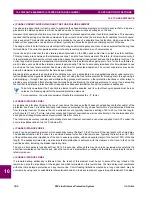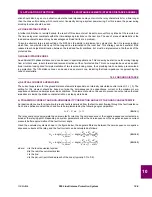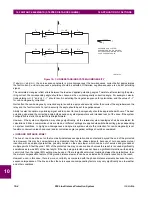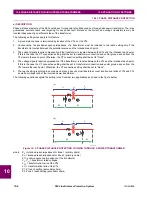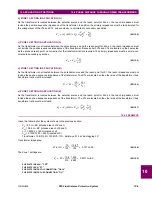
GE Multilin
D30 Line Distance Protection System
9-21
9 THEORY OF OPERATION
9.5 FAULT LOCATOR
9
9.5FAULT LOCATOR
9.5.1 FAULT TYPE DETERMINATION
Fault type determination is required for calculation of fault location – the algorithm uses the angle between the negative and
positive sequence components of the relay currents. To improve accuracy and speed of operation, the fault components of
the currents are used; that is, the pre-fault phasors are subtracted from the measured current phasors. In addition to the
angle relationships, certain extra checks are performed on magnitudes of the negative and zero-sequence currents.
The single-ended fault location method assumes that the fault components of the currents supplied from the local (A) and
remote (B) systems are in phase. The figure below shows an equivalent system for fault location.
Figure 9–9: EQUIVALENT SYSTEM FOR FAULT LOCATION
The following equations hold true for this equivalent system.
(EQ 9.7)
where:
m
= sought pu distance to fault,
Z
= positive sequence impedance of the line.
The currents from the local and remote systems can be parted between their fault (F) and pre-fault load (pre) components:
(EQ 9.8)
and neglecting shunt parameters of the line:
(EQ 9.9)
Inserting the
I
A
and
I
B
equations into the
V
A
equation and solving for the fault resistance yields:
(EQ 9.10)
Assuming the fault components of the currents,
I
AF
and
I
BF
are in phase, and observing that the fault resistance, as imped-
ance, does not have any imaginary part gives:
(EQ 9.11)
where: Im() represents the imaginary part of a complex number. Solving the above equation for the unknown
m
creates the
following fault location algorithm:
(EQ 9.12)
where
*
denotes the complex conjugate and
.
Depending on the fault type, appropriate voltage and current signals are selected from the phase quantities before applying
the two equations above (the superscripts denote phases, the subscripts denote stations).
For AG faults:
(EQ 9.13)
mZ
(1-m)Z
R
F
Z
A
Z
B
E
A
E
B
V
A
V
B
V
F
I
A
I
B
Local bus
Remote
bus
distance to fault
842780A1.CDR
V
A
m Z I
A
⋅ ⋅
R
F
I
A
I
B
+
(
)
⋅
+
=
I
A
I
AF
I
Apre
+
=
I
B
I
BF
I
Apre
–
=
R
F
V
A
m Z I
A
⋅ ⋅
–
I
AF
1
I
BF
I
AF
--------
+
⋅
-----------------------------------
=
Im
V
A
m Z I
A
⋅ ⋅
–
I
AF
-----------------------------------
0
=
m
Im
V
A
I
AF
∗
⋅
(
)
Im
Z I
A
I
AF
∗
⋅
⋅
(
)
----------------------------------------
=
I
AF
I
A
I
Apre
–
=
V
A
V
A
A
=
,
I
A
I
A
A
K
0
I
0
A
⋅
+
=
Summary of Contents for D30D00HCHF8AH6AM6BP8BX7A
Page 10: ...x D30 Line Distance Protection System GE Multilin TABLE OF CONTENTS...
Page 374: ...5 248 D30 Line Distance Protection System GE Multilin 5 10 TESTING 5 SETTINGS 5...
Page 398: ...6 24 D30 Line Distance Protection System GE Multilin 6 5 PRODUCT INFORMATION 6 ACTUAL VALUES 6...
Page 410: ...7 12 D30 Line Distance Protection System GE Multilin 7 2 TARGETS 7 COMMANDS AND TARGETS 7...
Page 444: ...9 24 D30 Line Distance Protection System GE Multilin 9 5 FAULT LOCATOR 9 THEORY OF OPERATION 9...
Page 576: ...B 102 D30 Line Distance Protection System GE Multilin B 4 MEMORY MAPPING APPENDIX B B...
Page 616: ...D 10 D30 Line Distance Protection System GE Multilin D 1 IEC 60870 5 104 PROTOCOL APPENDIX D D...
Page 628: ...E 12 D30 Line Distance Protection System GE Multilin E 2 DNP POINT LISTS APPENDIX E E...
Page 636: ...F 8 D30 Line Distance Protection System GE Multilin F 3 WARRANTY APPENDIX F F...
Page 646: ...x D30 Line Distance Protection System GE Multilin INDEX...

